Entry Database : PDB / ID : 3urfTitle Human RANKL/OPG complex Tumor necrosis factor ligand superfamily member 11, soluble form Tumor necrosis factor receptor superfamily member 11B Keywords / / Function / homology Function Domain/homology Component
/ / / / / / / / / / / / / / / / / / / / / / / / / / / / / / / / / / / / / / / / / / / / / / / / / / / / / / / / / / / / / / / / / / / / / / / / / / / / / / / / / / / / / / / / / / / / / / / / / / / / / Biological species Homo sapiens (human)Method / / / Resolution : 2.701 Å Authors Wang, X.Q. / Luan, X.D. / Lu, Q.Y. Journal : J.Immunol. / Year : 2012Title : Crystal Structure of Human RANKL Complexed with Its Decoy Receptor OsteoprotegerinAuthors : Luan, X.D. / Lu, Q.Y. / Jiang, Y.N. / Zhang, S.Y. / Wang, Q. / Yuan, H.H. / Zhao, W.M. / Wang, J.W. / Wang, X.Q. History Deposition Nov 22, 2011 Deposition site / Processing site Revision 1.0 Jul 11, 2012 Provider / Type Revision 1.1 Jul 29, 2020 Group Data collection / Database references ... Data collection / Database references / Derived calculations / Structure summary Category chem_comp / entity ... chem_comp / entity / pdbx_chem_comp_identifier / pdbx_entity_nonpoly / struct_conn / struct_ref_seq_dif / struct_site / struct_site_gen Item _chem_comp.name / _chem_comp.type ... _chem_comp.name / _chem_comp.type / _entity.pdbx_description / _pdbx_entity_nonpoly.name / _struct_conn.pdbx_leaving_atom_flag / _struct_conn.pdbx_role / _struct_ref_seq_dif.details Description / Provider / Type Revision 1.2 Oct 30, 2024 Group / Database references / Structure summaryCategory chem_comp / chem_comp_atom ... chem_comp / chem_comp_atom / chem_comp_bond / database_2 / pdbx_entry_details / pdbx_modification_feature Item / _database_2.pdbx_DOI / _database_2.pdbx_database_accession
Show all Show less
 Open data
Open data Basic information
Basic information Components
Components Keywords
Keywords Function and homology information
Function and homology information Homo sapiens (human)
Homo sapiens (human) X-RAY DIFFRACTION /
X-RAY DIFFRACTION /  SYNCHROTRON /
SYNCHROTRON /  MOLECULAR REPLACEMENT / Resolution: 2.701 Å
MOLECULAR REPLACEMENT / Resolution: 2.701 Å  Authors
Authors Citation
Citation Journal: J.Immunol. / Year: 2012
Journal: J.Immunol. / Year: 2012 Structure visualization
Structure visualization Molmil
Molmil Jmol/JSmol
Jmol/JSmol Downloads & links
Downloads & links Download
Download 3urf.cif.gz
3urf.cif.gz PDBx/mmCIF format
PDBx/mmCIF format pdb3urf.ent.gz
pdb3urf.ent.gz PDB format
PDB format 3urf.json.gz
3urf.json.gz PDBx/mmJSON format
PDBx/mmJSON format Other downloads
Other downloads 3urf_validation.pdf.gz
3urf_validation.pdf.gz wwPDB validaton report
wwPDB validaton report 3urf_full_validation.pdf.gz
3urf_full_validation.pdf.gz 3urf_validation.xml.gz
3urf_validation.xml.gz 3urf_validation.cif.gz
3urf_validation.cif.gz https://data.pdbj.org/pub/pdb/validation_reports/ur/3urf
https://data.pdbj.org/pub/pdb/validation_reports/ur/3urf ftp://data.pdbj.org/pub/pdb/validation_reports/ur/3urf
ftp://data.pdbj.org/pub/pdb/validation_reports/ur/3urf Links
Links Assembly
Assembly
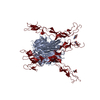
 Components
Components Homo sapiens (human) / Gene: TNFSF11, OPGL, RANKL, TRANCE / Production host:
Homo sapiens (human) / Gene: TNFSF11, OPGL, RANKL, TRANCE / Production host: 
 Homo sapiens (human) / Gene: TNFRSF11B, OCIF, OPG / Production host:
Homo sapiens (human) / Gene: TNFRSF11B, OCIF, OPG / Production host: 
 X-RAY DIFFRACTION / Number of used crystals: 1
X-RAY DIFFRACTION / Number of used crystals: 1  Sample preparation
Sample preparation SYNCHROTRON / Site:
SYNCHROTRON / Site:  SSRF
SSRF  / Beamline: BL17U / Wavelength: 1 Å
/ Beamline: BL17U / Wavelength: 1 Å Processing
Processing MOLECULAR REPLACEMENT / Resolution: 2.701→40.16 Å / Occupancy max: 1 / Occupancy min: 1 / FOM work R set: 0.8077 / SU ML: 0.33 / σ(F): 1.34 / Phase error: 24.86 / Stereochemistry target values: ML
MOLECULAR REPLACEMENT / Resolution: 2.701→40.16 Å / Occupancy max: 1 / Occupancy min: 1 / FOM work R set: 0.8077 / SU ML: 0.33 / σ(F): 1.34 / Phase error: 24.86 / Stereochemistry target values: ML Movie
Movie Controller
Controller



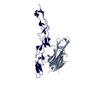

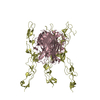
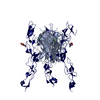
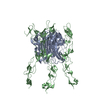

 PDBj
PDBj







